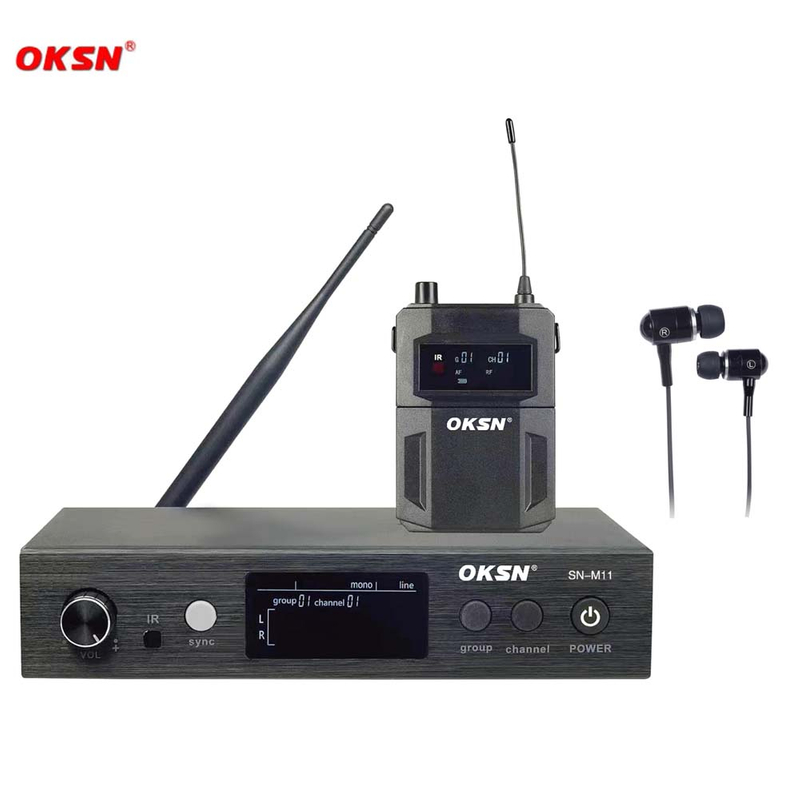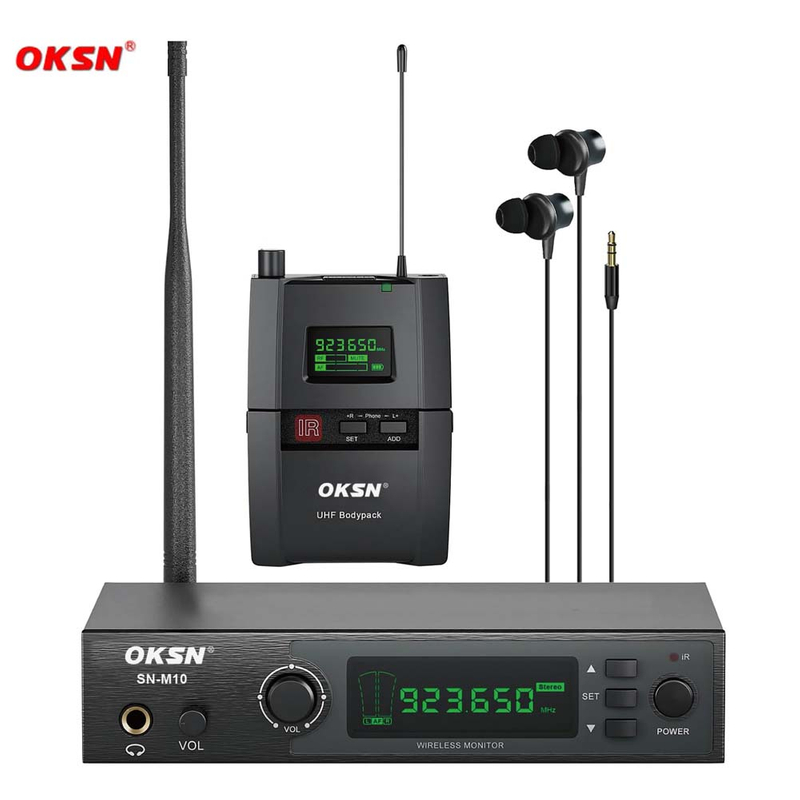- All
- Product Name
- Product Keyword
- Product Model
- Product Summary
- Product Description
- Multi Field Search
Views: 2 Author: Site Editor Publish Time: 2025-05-20 Origin: Site
Musicians and audio professionals know the unstoppable energy that drives every live performance. Yet, when it comes to delivering a flawless set, one piece of gear often makes the biggest difference—inner ear monitors. These compact devices have quietly revolutionized how artists experience and control sound on stage. This blog explores what makes inner ear monitors so essential, how they work, what to consider when choosing a pair, and why they’ve become the gold standard in music and beyond.
Curious about creating better sound or maximizing your stage experience? You’ll find actionable insights and expert tips right here.
Inner ear monitors, often called IEMs, are small earpieces designed to fit snugly inside the ear canal. Unlike standard earbuds or over-the-ear headphones, they are engineered to deliver precise, isolated audio directly to the listener. This allows musicians, vocalists, and audio engineers to hear a tailored mix on stage, even in the loudest environments.
The primary function of IEMs is to replace traditional stage wedges or floor monitors. By sending the audio feed straight to your ears, IEMs minimize interference from crowd noise, room acoustics, and stage feedback.
Every IEM system typically includes three main parts:
◇Transmitter: Takes the audio mix from the soundboard and sends it wirelessly.
◇Receiver: Clips onto a performer’s belt or clothing and picks up the audio signal.
◇Earphones (Monitors): Deliver the sound directly to the user’s ears.
Sound engineers use mixing consoles to create personalized mixes for each performer. This means a guitarist can have more guitar in their monitor, while a vocalist might want their voice front and center. The signal travels from the mixer to the transmitter, then to the receiver, and finally to the IEMs—with virtually no lag. The result is clear, reliable audio wherever you stand on stage.
The most celebrated advantage of inner ear monitors is noise isolation. IEMs create a seal in the ear canal, which blocks out ambient noise. Musicians don’t have to compete with stage volume or roaring fans, meaning they can focus more on pitch, timing, and performance.
Sound isolation also allows the audio feed to be played at lower volumes, reducing the risk of hearing damage over time.
Traditional wedges blast the same mix across the stage. This rarely suits everyone, especially with groups or acts featuring multiple instruments and vocals. IEMs solve this instantly. Each band member can enjoy a “custom recipe” of what they want to hear, improving cohesion and confidence during live shows.
Before IEMs, musicians were tethered to a small “sweet spot” where the wedge monitors sounded right. Move too far, and the mix would shift or blur. With wireless IEMs, performers have complete freedom to move, jump, and interact with the audience. Whether you’re a solo singer-songwriter or an arena headliner, that mobility is a game-changer.
Hearing loss is a serious occupational hazard among performers. Constant exposure to high stage volumes can permanently damage sensitive inner ear structures. IEMs allow musicians to control audio levels and often include built-in limiters to prevent dangerous spikes, helping safeguard their hearing for years to come.
Different venues, from intimate clubs to open-air festivals, pose unique acoustic challenges. IEMs deliver a consistent listening experience, so musicians aren’t at the mercy of unpredictable room acoustics or inadequate wedge setups.


Feature | Inner Ear Monitors | Floor Wedges |
|---|---|---|
Sound Isolation | Excellent | Poor |
Personal Mixes | Yes | Limited/Shared |
Mobility | Complete freedom | Fixed position |
Hearing Protection | Good (with safe use) | Often high volume |
Feedback Issues | Minimized | Common |
Portability | Highly portable | Bulky and heavy |
With so many options on the market, selecting your first (or next) pair of inner ear monitors can feel overwhelming. Here are the key factors to consider:
◇Universal IEMs come with multiple ear tip sizes and fit most users.
◇Custom-fit IEMs are molded to your ears, offering the best possible seal and comfort. They’re more expensive but favored by touring professionals.
Drivers are the tiny speakers in each earpiece responsible for producing sound. More drivers generally mean better sound quality and separation.
◇Single-driver IEMs are budget-friendly but may lack definition.
◇Multi-driver IEMs (up to six or more per earpiece) can articulate lows, mids, and highs for a rich, dynamic mix.
◇Wired IEMs offer reliability and are less prone to interference, ideal for studio or stationary settings.
◇Wireless IEMs give full mobility on stage, but require careful setup to avoid signal dropouts.
Preferences vary. Some IEMs highlight bass frequencies, while others offer a flatter, more accurate profile. Test different models to find what best matches your music and listening goals.
Look for reinforced cables, sweat-resistant housings, and replaceable components. Tour-ready IEMs withstand heavy use and environmental challenges.
Entry-level IEMs suitable for beginners or small venues may cost under $100, while professional-grade custom sets can reach $1000 or more.
◇Get Properly Fitted: The right fit is vital for comfort and sound isolation. Don’t ignore signs of ear fatigue or irritation.
◇Monitor Your Volume Levels: Tempting as it is, louder isn’t always better. Safe listening practices will protect your hearing long-term.
◇Stay Aware of Surroundings: IEMs block out much external noise, so be cautious moving around busy stages or venues.
◇Keep Gear Clean: Regularly clean ear tips and cases to avoid buildup of sweat and debris.
While IEMs were once reserved for big-budget touring acts, they’re now a staple for:
◇Singers and instrumentalists on stage seeking precise monitoring
◇Audio engineers who value accurate sound references
◇Broadcast teams and presenters who need clear cues during live TV or radio
◇Audiophiles desiring studio-grade listening on the go
◇Fitness instructors and public speakers in noisy venues
Their adaptability and consistent audio quality mean IEMs are also making inroads in podcasting, content creation, and live-streaming spaces.
Thinking about switching to IEMs? Here’s how to integrate them smoothly:
1.Test in Rehearsals. Set up a simple system and get comfortable before any big shows.
2.Work Closely with Your Sound Engineer. Good communication ensures each performer’s mix meets their needs.
3.Consider Ambient Mics. Some performers miss hearing crowd reactions with full isolation. Add room microphones into your mix for some situational awareness.
4.Have a Backup Plan. Keep wired headphones or a pair of wedges handy in case of technical glitches.
Inner ear monitors represent more than a tech upgrade. They’re a strategic move toward better performance, greater comfort, and long-term hearing health. Whether you play small venues or giant arenas, adopting IEMs can redefine your music and your career.
Explore reviews, consult industry peers, and try out several IEM models to discover what fits you best. The sound revolution is happening now, and it’s as close as your next rehearsal.
Exhibition Name: The 124th Canton Fair Booth number:5.1 L31 Date:15-19 Oct. 2018 Address: China export&import commodity exhibition center ( Pazhou pavilion)
Dear Sirs /Madam:We hereby sincerely invite you and your company representatives to visit our booth at the Canton Fair from April 15th to 19th on 2019.It would be a great pleasure to meet you at the exhibition .We expect to establish long-term business relations with your company in future .Exhibiti
OKSN Electronics Technology Co. Ltd.was established in 1997. It lies in the microphone production base--En'ping City, Guangdong Province, China.Our factory is a professional manufacturer for microphone integrated with designing,investment,produce and sell. The products include wire/wireless microp
China has become the global epicenter for audio equipment manufacturing, with specialized microphone factories driving innovation and meeting worldwide demand. Among the key manufacturing regions, Guangdong Province stands out as a premier destination for high-quality microphone production, housing
Musicians, sound engineers, and performers know that crystal-clear audio monitoring can make or break a live performance. Traditional floor monitors often create feedback issues and limit stage movement, making wireless in ear monitor systems the preferred choice for professional audio applications.
Nothing kills the karaoke vibe faster than poor sound quality. Whether you're belting out power ballads or attempting rap verses, your performance deserves an amplifier that can keep up with your energy and deliver crystal-clear audio to your audience.A 200 watt amp represents the sweet spot for mos
Whether you're creating content for YouTube, conducting interviews, or presenting at conferences, audio quality can make or break your message. While smartphone cameras have reached impressive levels, their built-in microphones still struggle to capture clear, professional sound. This is where wirel
Microphone wire forms the backbone of professional audio systems, yet many people overlook its importance until something goes wrong. Whether you're setting up a home studio, preparing for a live performance, or building a recording setup, understanding microphone wire can make the difference betwee
In today's digital age, remote meetings, webinars, and virtual conferences have become the norm. Whether you're hosting a business meeting, an online class, or a podcast, clear audio is essential for effective communication. This is where a USB conference microphone comes into play. Designed for gro
In an era dominated by wireless technology, wired headphones with microphones remain a popular choice for many users. Whether you're a gamer, a professional, or someone who enjoys high-quality audio, wired headphones offer reliability, superior sound, and consistent performance without the need for
Choosing the right audio sound mixer can transform your recording, live performance, or broadcasting setup from amateur to professional. With countless options available, finding the perfect mixer requires understanding your specific needs, budget, and technical requirements.This comprehensive guide
Setting up audio equipment used to mean dealing with tangled cables, limited mobility, and constant technical headaches. Wireless microphone systems have revolutionized how we capture and transmit audio, offering freedom of movement without sacrificing sound quality.Whether you're a content creator,
Sound engineers, content creators, and musicians know that location doesn't always come with convenient power outlets. Battery powered mixer audio equipment has revolutionized how we approach portable sound mixing, offering professional-grade audio control without the constraints of wall power. Whet
When it comes to delivering great audio for live performances, speeches, broadcasts, or even studio recordings, professional handheld microphones remain a favorite among industry professionals. Known for their versatility, ease of use, and high-quality sound capture, these microphones are essential
Microphone technology plays a pivotal role in ensuring smooth worship services, impactful sermons, and beautiful choir performances. For churches, cordless microphones offer game-changing convenience and freedom of movement, enabling pastors, worship leaders, and performers to deliver their messages
If you're looking for freedom, mobility, and unmatched sound quality, wireless in-ear monitors (IEMs) are the game-changer you didn’t know you needed. Whether you're an audiophile, a musician performing on stage, or someone who simply wants to experience sound on a whole new level, wireless IEMs off
Wireless microphones have quickly become essential tools for professionals and content creators alike. Whether you're a filmmaker, vlogger, podcaster, or presenter, having a reliable wireless microphone system ensures crystal-clear audio, unrestricted mobility, and a touch of professionalism that el
Introduction Whether you're a content creator, podcaster, or filmmaker, great audio is essential to enhancing your audience's experience. Wireless microphones have become a game-changer for capturing high-quality sound effortlessly, and Rode, a globally respected brand in the audio industry, offers
Effective communication is at the heart of productive meetings and conferences. But achieving crystal-clear audio, especially in larger or hybrid setups, can be a challenge. That's where a wireless conference microphone system steps in to revolutionize the way we engage in group discussions, webinar
Wireless microphones have become indispensable in audio technology, offering freedom of movement and clutter-free setups. Among various types, VHF (Very High Frequency) wireless microphones are a popular choice for many professionals and hobbyists alike. Their affordability, ease of use, and range m